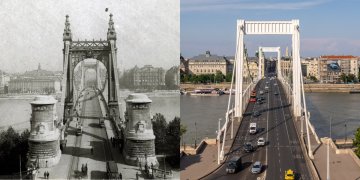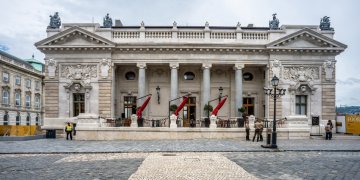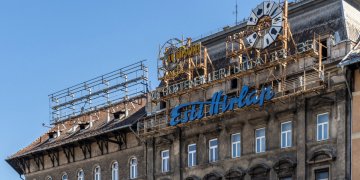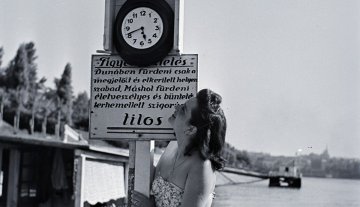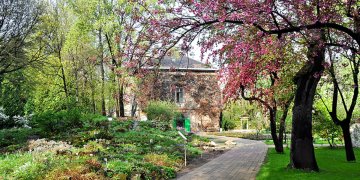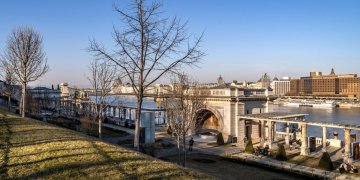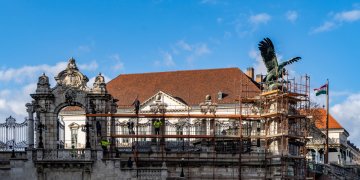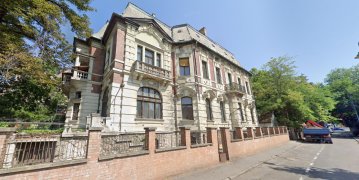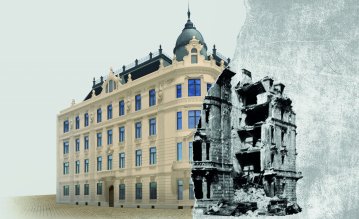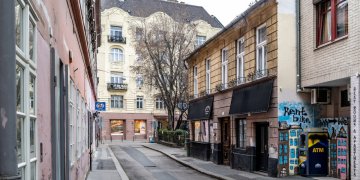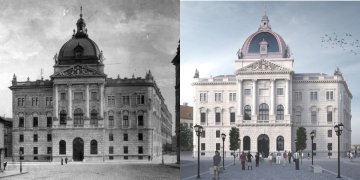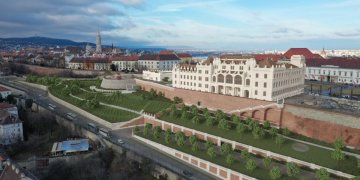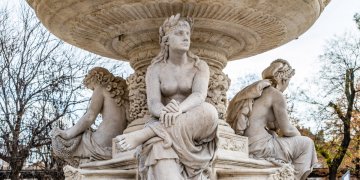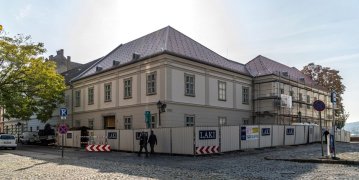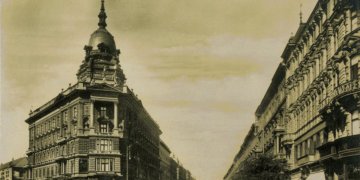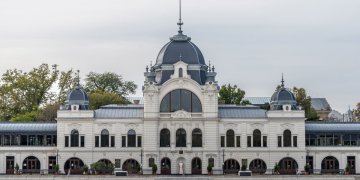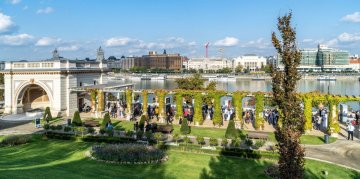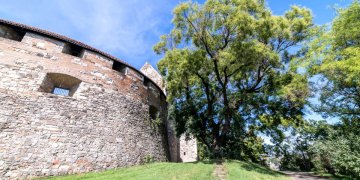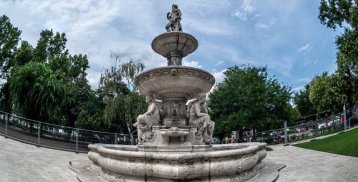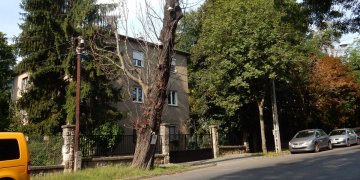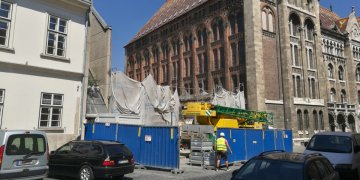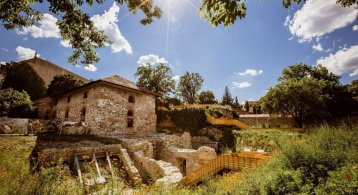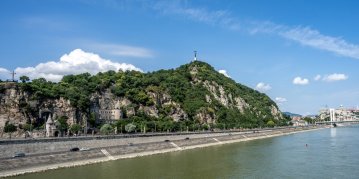
Bukovszki Péter
Cikkek
Budapest then and today – 5 photos showing how much the city has changed over a century
June 24, 2021 at 9:00 AM
Comparing past and present is always exciting. Walking around the city, one can often wonder what this or that street used to look like, what houses stood, and which were built later. If someone looks at an archive picture, the old buildings that still stand today, such as the Parliament or the St. Stephen's Basilica, help them find their way. At the same time, they can admire the once small-town atmosphere of Csalogány Street, the almost unrecognisable Deák Square or the old Erzsébet Bridge that many still consider to be one of the most beautiful bridges built in Hungary.
Guardians of Buda Castle – traditions of the Hungarian Royal Guards come to life in the café of the Guard House
June 10, 2021 at 10:00 AM
After almost fifty years, the Guard House (Főőrség) once again stands in full beauty on the western side of the Hunyadi courtyard. The recently opened café revives the traditions of the Hungarian Royal Guards. The exhibition on the first floor presents the history of the military unit of Hungary with the help of original uniforms, weapons, and copies of contemporary documents. The café's menu evokes the heyday of the Budapest café culture. Its interior refers to the colours of the guard's uniforms, which was one of the top Hungarian national uniforms. Pestbuda asked managing director István Bottyán about the past and present of the renewed Guard House.
Neons lost – Many billboards on Rákóczi Road are reminiscent of old times
June 8, 2021 at 9:00 AM
Hundreds of neon signs used to fill Budapest at night with colourful light. However, the lamps constantly needing to be maintained and wasting energy were replaced by more modern advertisements decades ago. However, many of the advertising signs or their rusty remnants can still be seen in their original place to this day, damaging the cityscape.
Timing trouble – The difficulties of introducing a 24-hour clock system
June 1, 2021 at 9:00 AM
Today, it is natural for a train to depart Nyugati Railway Station not at 1 pm, but at 13:00, but on 1 June 1921, this was a surprising novelty. The 24-hour clock system, introduced a hundred years ago, was unusual for the people of Budapest even years later. However, even clock faces were redesigned because of the change.
The home of 5 lakes - Ten interesting pictures of the 250-year-old Füvészkert
April 26, 2021 at 9:00 AM
It has been operating in its current location for 174 years, its oldest trees, the fern pines, have lived through 200 springs, and its fairy roses were admired by members of the royal family. In its area, which once was the park of Festetics Palace, there were once 5 lakes, and its glasshouse was known to generations from The Paul Street Boys. Take an imaginary walk in the 250-year-old Füvészkert (ELTE Botanical Garden; 'herb garden') with ten carefully selected pictures.
From Triton's Well to Ifipark - The stories of the Castle Garden Bazaar
March 12, 2021 at 10:00 AM
The Neo-Renaissance garden of the Castle Garden Bazaar was built between 1874 and 1882. It is a worthy pair to any palace garden in the world and houses many details that have exciting stories to tell beyond their beauty: the Triton Fountain, the garden's budding roses, and the medieval curtain wall could each tell hundreds of stories if not sentenced to silence. So let us tell their stories for them.
Restoration of Habsburg Gate and Turul statue in Buda Castle has begun
February 19, 2021 at 9:00 AM
The ornate gate built during the Hauszmann-reconstruction of Buda castle stands at the Szent György Square station of the Buda Castle Funicular. The ornate fence, stairs, and the adjoined great Turul statue – erected in 1905 – are being restored.
Refuge for a Queen – Queen Consort Elizabeth's love for Buda Castle
February 13, 2021 at 10:00 AM
The story of how Franz Joseph's beautiful wife went from being unknown in Hungary to become "our Queen consort", often referred to simply as Sisi, is fascinating. The Queen learnt Hungarian, was happier in Buda than Vienna, and her death shook the entire nation. Her friendship with Gyula Andrássy is well-known, and it was in part her efforts that transformed Franz Joseph (Ferenc József), the cruel oppressor, to the diminutive Ferenc Jóska.
Life after assassination – Róheim Villa, where István Tisza was killed to be restored
February 11, 2021 at 9:00 AM
Near City Park, the eclectic villa building at 45 Hermina Road, completed in 1900, is to undergo a comprehensive renovation. Its facade and roof will be rebuilt, and the lavish but now dilapidated interior restored. A fountain will be installed in the garden and valuable trees preserved.
Reconstruction of the former Red Cross headquarters on Dísz Square to begin in 2021
January 29, 2021 at 9:00 AM
Designed by Alajos Hauszmann and Dezső Hültl, the palace once housed the Red Cross Society, and then the Ministry of Foreign Affairs. The representative spaces of the palace, torn down after World War II, and its façade will be rebuilt according to the original plans. Other areas will be reimagined for the modern age.
Historical buildings avoid destruction in Budapest city-centre
January 17, 2021 at 1:00 PM
In response to recent events, the Prime Minister's Office has ordered the initiation of listing two buildings as historical monuments of Budapest. All work must stop on the Márványmenyasszony ('marble-bride') restaurant in the 1st District, which hosted the weddings of historical figures such as Széchenyi and Wesselényi and the house on Kazinczy Street, which has become known as Tamás Wichmann's pub. Although the future of these buildings remains uncertain, their history is known all the better.
Rebirth: Historic palace at 47 Andrássy Avenue restored
January 6, 2021 at 9:00 AM
The building has housed one of the most beautiful cafes in Budapest, a casino, a pharmacy, a glove shop and a car dealership. Until recently, the building that once housed Café Palermo was a black sheep on Andrássy Avenue, but the era of real-estate related corruption and degradation has come to an end. Standing on the corner of Liszt Ferenc Square and Andrássy Avenue, the building currently hidden by a safety net, which hides the luxury apartments being built as part of the restoration.
Rebuilt Headquarters of Hungarian Defense Forces will act as gate to the Palace of Buda Castle
December 22, 2020 at 9:00 AM
One hundred and twenty years ago its massive dome was the pride of Dísz Square. However, for the last 70 years, the military headquarters' partially deconstructed remains have lacked form and function. However, this is set to change. After a partial renovation between 2012 and 2014, its continued reconstruction will begin next year, restoring the building to its former glory, and serving visitors to Buda's Castle District.
Fehérvári Roundel and Western Gardens of Buda Castle to be renovated, new parking garage planned
December 11, 2020 at 10:00 AM
The Fehérvári Roundel and its surroundings are to be demolished and rebuilt to its original size in Buda Castle. One of the main goals of the National Hauszmann Program is to allow visitors to Buda Castle to explore the Castle District by walking around it on its walls. The Fehérvári Roundel plays a major role in enabling this. Following the reconstruction, a previously closed section of the western castle wall will be opened, connecting the roundel to Csikós Courtyard. The western gardens will be revitalised to evoke the vineyards and orchards that once surrounded Budavár. Várgarázs III. will meanwhile further reduce the number of cars parked in the Castle.
Renovation of Danubius Fountain Completed – Footless Szava restored
December 9, 2020 at 2:00 PM
One of the most beautiful and largest fountains in Budapest, the Danubius Fountain on Erzsébet Square, has undergone a comprehensive renovation in recent months. Its stones have been cleaned, missing parts replaced, and even worn gilding replaced.
Stunning house with famous underground safe renovated in Buda Castle
November 13, 2020 at 10:00 AM
The house under 72 Úri Street and its underground tunnels once housed Hungary's gold reserves during the second world war and 600–700 people alongside them. In the 1950s the location was used to control the electrical grid. The house has newly been restored to its original late-baroque design as the educational centre of the Hungarian National Bank.
Ten stunning domes lost from the Budapest cityscape
November 8, 2020 at 10:00 AM
Following a recent decision reached by the government, the domes and roof ornaments of buildings may be reconstructed around the country. The first three will be completed within a pilot project in Budapest. This list from Pestbuda collects ten buildings that were once famous for their roofs and which we believe should be among the first to be replaced.
Imre Francsek – Lesser known architect behind City Park Skating Rink died 100 years ago
October 30, 2020 at 11:00 AM
The architect behind the ice skating rink in City Park, the colonnade of the Saint Gerard statue, the Buda Civic Casino and several residential buildings. If all his plans had been carried out, Calvin Square and Szabadság Square would be very different. At one point in his career, he even proposed pushing the entire Dreher Palace a few metres to the side. Imre Francsek died one hundred years ago.
Legends from Buda Castle: Descendants of Hauszmann and Strobl join opening of new photographic exhibition in the Castle Garden Bazaar
September 25, 2020 at 12:00 PM
The descendants of the Alajos Hauszmann, the Teleki family and Alajos Strobl can be seen in the portraits newly on display on the Southern Panorama Terrace of the Castle Garden Bazaar. The exhibition entitled legends from Buda Castle – open until 15 November – highlights the connections between the Castle and Budapest through the lives of people deeply connected to the Castle District.
A Garden for Kings – The oldest trees of Buda Castle each have a story to tell
September 19, 2020 at 10:00 AM
Standing mementoes of the lost glory of royal gardens the old trees of Buda hold something of the Castle's history. The Japanese pagoda trees, fruit-bearing fig-trees, stunning oaks, lindens and planetrees, or mulberry trees from a time when Hungary produced silk, all have stories to tell. But they do need some help...
Danube, Tisza, Drava, Sava – Beautiful fountain in Budapest city centre to be renovated
September 16, 2020 at 3:00 PM
A beautiful fountain can be found in the centre of Budapest. Designed by Miklós Ybl, it depicts what were once the four largest rivers of Hungary: the Danube, the Tisza, the Drava and the Sava. Originally erected on Kalvin Square in 1883 it was severely damaged in the Second World War. A copy of the fountain and its statues were later erected on Erzsébet Square. Sadly, these were damaged, not by armed conflict but simply passers-by, leading to the foot of the Sava figure being broken off – a fault that will also be repaired with the complete renovation of the fountain.
Several weakened trees to be felled in Budapest
September 12, 2020 at 9:00 AM
Urban trees require constant care. As part of urban tree care in September, several dangerous, ill and weakened trees will be cut down and new saplings planted in their places. Complete tree-lined streets will be renewed in Wekerletelep in Kispest.
Most of the National Electric Load Distributor in the Castle has been demolished
August 14, 2020 at 9:00 AM
The demolition of the controversial-looking industrial building next to the Bécsi Kapu Square Palace of the Hungarian National Archives has progressed quickly in recent weeks. Only the tower, part of the iron structure and a firewall remain. The former National Electric Load Distributor that has been in a dilapidated condition for a long time will be replaced by a house
The lid of a Venetian cure-all and a medieval staircase have been unearthed in the newest cultural area in Buda Castle
August 7, 2020 at 11:00 AM
The outdoor site of 9 Táncsics Street has been reborn as the T9 - The First Bastion archaeological exhibition and cultural community space. The former József Barracks and Prison building is continuously revealing the layers of its history. During the current archaeological excavation, the remains of a medieval and Ottoman building that used to stand here have emerged from under the floor of the house.
A neglected landmark – A walk on Gellért Hill
August 1, 2020 at 1:30 PM
Despite it being a symbol of Budapest, a popular walking destination, and a nature reserve in the city's heart, Gellért Hill has been neglected for decades. Unfortunately, the situation is beyond slight renovation – a complete replanning and reconstruction are needed.

